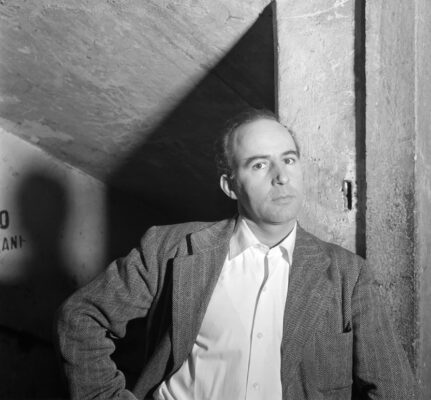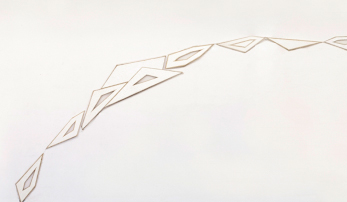Angelo Savelli was born in Pizzo Calabro in 1911. Trained at the Academy of Fine Arts in Rome under the guidance of Ferruccio Ferrazzi, in 1936 he decorated the chapel of Villa Boimondi in Sora (Frosinone) in fresco. In 1938, having finished his military service, he obtained the chair at the Liceo Artistico in Rome, settling in a studio in via Margutta, where he was able to associate with the protagonists of the national artistic context, including Guttuso, Franchina, Jarema, Fazzini, Severini and many others. There are various awards in this period: awarded in the meantime at the Lazio Regional Exhibition, in 1941 he held his first personal exhibition at the Galleria Roma and, in the same year, he participated in the Bergamo Prize, receiving an award renewed for him the following year.
Starting from 1947 he began to exhibit, on the initiative of Carlo Cardazzo, at the Galleria del Naviglio in Milan, at the Galleria del Cavallino in Venice and at the Galleria Selecta in Rome.
After the war he took part in the foundation of the Art Club group and in 1948 obtained a scholarship for a month's stay in Paris, where he extended his stay to a year. The Parisian experience is a revelation for the artist. He will declare: “I realized that I had to free myself from my divine Italian tradition”. During this period, he realised numerous ink and watercolor drawings. After the expressionist phase linked to the Roman years, in 1949 he returned from the French capital with a new artistic sensibility. In Rome he meets Theodoros Stamos. From 1950 are the two works Oltre l'inquieto, which mark the beginning of abstraction. It is the year in which he appears at the XXV Venice Biennale, where he returns to exhibit in 1952.
In 1953 he married the journalist Elisabeth Fischer. After moving to New York, Angelo Savelli frequented the artistic circuit of Tenth Street and the exponents of the New York School, including Jack Tworkov, who gave him the studio between 10th Street and 4th Avenue. In 1956 with the monochromatic serigraphy Bianco su bianco he created his first entirely white painting, partly derived from his interest in meditation and oriental philosophies. After a solo exhibition at the D'Amecourt Gallery in Washington in 1957, the following year he was invited to exhibit in a one-man show at the Leo Castelli Gallery, then at the Galleria del Cavallino in Venice. In 1959 he was appointed director of the art school "La Guardia Memorial House".
In 1960 he began his activity as a teacher at the Graduate School of Fine Arts of the University of Pennsylvania in Philadelphia, together with Piero Dorazio, a position he will hold for ten years, during which he maintains his studio in New York. In the meantime, Savelli does not interrupt relations with Italy. In 1961 he won the Lissone prize and the following year it was presented by Giulio Carlo Argan at the Galleria Pagani del Grattacielo in Milan. In 1964 he won the Graphics Grand Prix at the XXXII Venice Biennale with twenty-seven white reliefs.
Between 1964 and 1969, in his studio on Bowery Street in New York, he created the first meditation room he named Paradise. Followed, between 1969 and 1970, the Paradise II projects presented at the Corcoran Gallery of Art in Washington, and Dante's Inferno at the Peale Galleries of Pennsylvania in Philadelphia. From 1966, and throughout the following decade, he taught at various American universities, such as Columbia University in New York, the University of Wisconsin-Stout, Cornell University in Ithaca (New York).
In the '70s Angelo Savelli continued his artistic research on installations, strictly white, and created works such as Wall to wall of 1975-1976 in which themes related to minimal Art prevail. In the following decade his exhibition activity intensifies, with exhibitions in the United States, Italy and Switzerland.
In 1980 he received the “Guggenheim Fellowship” from the Guggenheim Museum in New York which allowed him to live in Europe and organize personal exhibitions in Milan, Zurich and Rome.
In 1982, the year in which the volume by Giuseppe Appella Angelo Savelli. Opera grafica 1932-1981 was published by Scheiwiller, the Municipality of Pizzo Calabro awards him a gold medal for artistic merits. The following year he obtained the American Academy of Arts and Letters Award.
In 1984, the year of the personal exhibition at the PAC - Padiglione d'Arte Contemporanea in Milan, Savelli created a monumental work, developed over a length of 1,650 cm, in homage to his wife who died two years earlier: Glory of a Broken Wing, to Elisabeth Fischer.
In 1987 the installation Inficosmo, created for the Studio D'Ars in Milan, was permanently transferred to the Civic Museum of Gibellina. The following year he devoted himself exclusively to sculpture working in Albisola. In 1988 Savelli moved into what was to be his last studio, at 257 Water Street in New York. The same year the Rai Corporation of New York made a film about his life directed by Luigi Ballerini.
In 1989 at the Rai Corporation in New York he met Susanna Argenterio, whom he loved like a daughter.
In 1991 the "Angelo Savelli Contemporary Art Center" was inaugurated in Lamezia Terme in Calabria. Then, on March 10, 1995, Savelli left New York and returned permanently to Italy to follow the organization of two important exhibitions scheduled for June: the anthology at the Museum of Contemporary Art in Prato "Luigi Pecci", curated by Antonella Soldaini, Susanna Argenterio and in collaboration with "PradaMilanoArte", and the personal room at the XLVI Venice Biennale organized to celebrate the centenary of the international event. But the artist did not have the opportunity to see these two important events take place for a few weeks. On 27 April 1995, while he was a guest of the Argenterio Ghidini family, Savelli died at the age of eighty-three in the Boldeniga Castle in Dello, near Brescia, his favorite place during his stays in Italy.

